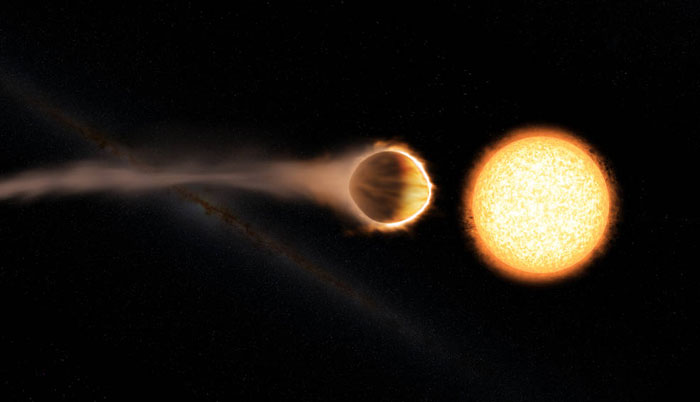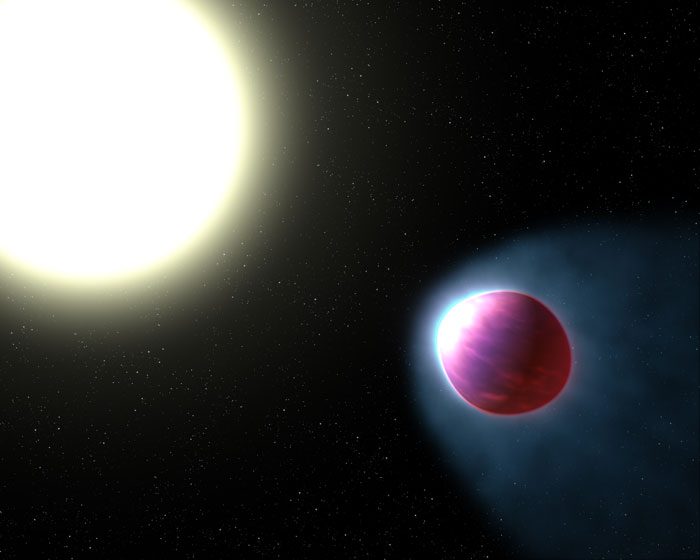For the first time, scientists have detected water molecules "glowing" around a planet outside our Solar System, giving us the best evidence yet of an exoplanet with a stratosphere.
It's a huge find, and one that could tell us a lot more about the science of Hot Jupiters – a mysterious class of insanely toasty Jupiter-ish gas giants that are common throughout the galaxy, but not found inside our own solar neighbourhood.
Before we get too carried away with the stratosphere discovery, it's important to note that Hot Jupiters like the exoplanet in question – WASP–121b, which is located approximately 900 light-years from Earth – aren't themselves likely to support life, on account of their scorching environments.
But understanding more about their atmospheres is a big step in figuring out the physical and chemical conditions that make up alien worlds – which, it turns out, may not be quite so alien after all.
 Engine House VFX/At-Bristol Science Centre/University of Exeter
Engine House VFX/At-Bristol Science Centre/University of Exeter
"This result is exciting because it shows that a common trait of most of the atmospheres in our Solar System – a warm stratosphere – also can be found in exoplanet atmospheres," says one of the researchers, Mark Marley from NASA's Ames Research Centre.
"We can now compare processes in exoplanet atmospheres with the same processes that happen under different sets of conditions in our own Solar System."
The team detected glowing water molecules in WASP–121b's atmosphere by using NASA's Hubble Space Telescope, with a spectroscopic analysis showing the water molecules giving off infra-red radiation as they lost energy due to increases in heat in the planet's extraordinarily hot stratosphere.
We're talking around 2,500 degrees Celsius (4,600 degrees Fahrenheit) in the upper atmosphere, so definitely on the steamy side.
While we often think of evidence of water as being a tell-tale sign of a chance for life on distant spheres, that's unlikely to be the case with WASP–121b though.
The world may be like Jupiter in a couple of areas – its mass is 1.2 times Jupiter's mass, its radius about 1.9 times – but by at least one important criterion, it's incredibly different.

Unlike Jupiter, which distantly orbits the Sun once every 12 years, WASP–121b's uber-tight orbit sees it loop around its host star in a tidy 1.3 days.
That intense proximity explains why it's not a planet we – or anybody else for that matter – could probably ever live on, and if it hovered any closer to its star, the star's gravity would actually rip it apart.
But while that hellish heat means you should cancel any planned sightseeing, it made for the perfect backdrop to show off water fizzing in near-space, even 900 light-years away.
"When it comes to distant exoplanets, which we can't see in the same detail as other planets here in our own Solar System, we have to rely on proxy techniques to reveal their structure," says astronomer Drake Deming from the University of Maryland.
"The stratosphere of WASP–121b is so hot it can make water vapour glow, which is the basis for our analysis."
The researchers say that the light show resulted from temperature increases in WASP–121b's stratosphere of about 560 degrees Celsius (1,000 degrees Fahrenheit).
While they're not altogether sure what chemicals in the upper atmosphere are absorbing so much of the starlight to trigger this transition, the team speculates vanadium oxide and titanium oxide may be at play, which are thought to only occur in the hottest of Hot Jupiters.
 NASA/ESA/G. Bacon (STSci)
NASA/ESA/G. Bacon (STSci)
Solving that mystery will be part of the focus of future observations – with a goal to uncovering more about what makes Hot Jupiters the strange worlds they are, and helping us refine the search for other kinds of planets that could maybe support life.
"[Hot Jupiters] are a first step towards honing our skills, developing our tools, getting ready for the things that are more Earth-like," astronomer Kevin Heng from the University of Bern, who reviewed the study, told The Verge.
"This is the first step in a long road."
The findings are reported in Nature.
